In systems requiring the transmission of power and electrical signals from a stationary structure toward a rotating one, slip rings are a pivotal component. In essence, they are electromechanical devices that maintain a continuous electrical connection between stationary and rotating systems, allowing unconstrained rotation. This characteristic makes slip rings indispensable in various applications – from wind turbines to electric motors, and from radar systems to cable reels.
Among various types of slip rings, the IP-rated enclosed slip rings stand out due to their unique attributes and varied applications. The term ‘IP-rated’ refers to ‘Ingress Protection,’ a standard that signifies the level of protection provided by the slip rings against solid objects, dust, and liquids. When enclosed in robust housing, they offer heightened protection, particularly against environmental contaminants and hazards, expanding their usage into challenging, critical environments.
This comprehensive guide aims to provide an in-depth understanding of these unique components: IP-rated enclosed slip rings. Devised to serve professionals, enthusiasts, and newcomers to the field alike, this guide covers a broad spectrum of key aspects. This includes – but is not limited to – an overview of IP ratings, types of IP-rated enclosed slip rings, their working principles, significant features, practical applications, and essential considerations during selection, installation, and maintenance.
Informed by industry insights and future trends, this guide serves to equip readers with the knowledge to make well-informed decisions concerning IP-rated enclosed slip rings and optimally utilize their benefits.
Understanding IP Ratings
IP rating stands for “Ingress Protection” rating and is an international standard used to specify the degree of protection provided by an enclosure against intrusion from foreign bodies and moisture. An essential part of understanding IP-rated enclosed slip rings lies in comprehending the IP rating system.
The IP rating system consists of two digits that follow the ‘IP’. The first digit represents the level of protection against solid objects and particulates, ranging from 0 (no protection) to 6 (complete protection against dust). The second digit symbolizes the degree of protection against liquids, spanning from 0 (no protection) to 9K (protection against powerful high-temperature water jets and immersion).
You are most likely to encounter IP ratings such as IP54, IP65, and IP68 attached to slip rings. An IP54 rating, for example, indicates that the slip ring is protected against limited dust ingress and water sprays from any direction, while an IP65 rating symbolizes complete dust protection and resistance against low-pressure water jets from any direction. The highest of these common ratings, IP68, represents dust tightness and protection against prolonged effects of immersion under pressure.
Understanding IP ratings is of paramount importance as it directly impacts the selection and usage of slip rings. It indicates the environment in which a slip ring can function optimally without undue wear and tear or risk of failure. It also provides users with a reliable measure to compare and contrast different slip rings, based on their respective IP ratings, and find the one that suits their specific needs the best. It informs about the slip ring’s potential for durability and longevity, becoming an indicative marker of overall operational efficiency and cost-effectiveness. Consequently, a comprehensive understanding of IP ratings isn’t just recommended, but often necessary, for professionals working with, or around, these essential electromechanical devices.
Types of IP-Rated Enclosed Slip Rings

As mentioned earlier, slip rings are available in various IP ratings, resulting in a range of IP-rated enclosed slip rings that cater to diverse environmental conditions and application requirements. In this section, we will explore the classification of these slip rings based on IP ratings, unique features, primary differences, and their suitability for specific scenarios.
Classification Based on IP Ratings
IP-rated enclosed slip rings are classified according to their respective IP ratings, which reflect their protection levels against solid objects and liquids. Some of the most common IP ratings in slip rings include IP54, IP65, and IP68.
Features and Differences in the Types
- IP54 Slip Rings: Slip rings with an IP54 rating provide protection against limited dust ingress and splashing water from any angle. These slip rings feature a dust-resistant design and can handle water splashes without succumbing to damage, making them ideal for use in environments with minimal exposure to dust and moisture.
- IP65 Slip Rings: An IP65 rating represents complete dust protection and resistance against low-pressure water jets projected from any direction. IP65 enclosed slip rings offer a fully dust-tight sealing while also withstanding the impact of low-pressure water sprays, making them more suitable for challenging environments that require a higher degree of dust and water resistance.
- IP68 Slip Rings: The IP68 slip rings are the most robust among the common IP ratings in terms of sealing, offering complete protection against dust ingress and prolonged immersion in water (up to specific depths mentioned by the manufacturer). They are specifically designed to function optimally even in highly challenging environments where exposure to large amounts of dust and extended water contact is expected.
Suitable Scenarios for Each Type
- IP54 Slip Rings: These slip rings are fitting for applications exposed to moderate amounts of dust and occasional water splashes, like factory automation equipment, packaging machines, or outdoor surveillance systems.
- IP65 Slip Rings: IP65-rated slip rings are more versatile, and often used in demanding environments such as wind turbines, outdoor electrical distribution systems, and car wash facilities, where full dust protection and resistance to low-pressure water jets are imperative.
- IP68 Slip Rings: When it comes to highly challenging and severe conditions, IP68 enclosed slip rings are the top choice. Their superior resistance to dust and water makes them optimal for underwater applications, submersible pumps, marine industries, or heavy-duty outdoor equipment that requires consistent immersion or exposure to water and harsh environmental elements.
Existing Products of Each Type
There are various types of slip rings, each with diverse IP ratings. For example, PIN slip rings mostly come with IP54 to IP68 ratings, catering to ordinary indoor applications and some harsh outdoor environments. Pancake slip rings, in contrast, usually are sealed up to IP51, primarily suitable for indoor conditions.
PIN Slip Rings
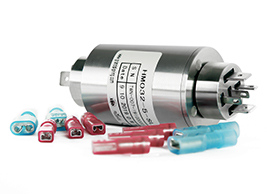
PIN slip rings are the substitute for mercury slip rings. Mercury slip rings use liquid metal mercury as a transmission medium. Special sealing technology, insulation, and compact design made them outstanding features like extremely long working life, low electrical noise, and contact resistance. Mercury is a chronic toxic substance. There have great potential threat to both the environment and the operators if leaked. People have been actively searching for alternative products.
Model | Picture | No. of Rings | OD(mm) | Rated Current | RPM | IP | |
2 | 32 | 20A | 0~400 | IP54 | |||
2 | 32 | 20A | 0~400 | IP65 | |||
2 | 32 | 20A | 0~400 | IP68 | |||
3 | 32 | 5A/20A | 0~400 | IP54 | |||
3 | 32 | 5A/20A | 0~400 | IP65 | |||
3 | 32 | 5A/20A | 0~400 | IP68 | |||
4 | 32 | 5A/20A | 0~400 | IP54 | |||
4 | 32 | 5A/20A | 0~400 | IP65 | |||
4 | 32 | 5A/20A | 0~400 | IP68 | |||
5 | 32 | 5A/20A | 0~400 | IP54 | |||
5 | 32 | 5A/20A | 0~400 | IP65 | |||
5 | 32 | 5A/20A | 0~400 | IP68 |
1 Passage Pneumatic + Electrical Rotary Joints
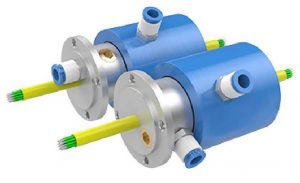
◆ Support M5, G1 / 8, G1 / 4, G3 / 8, G1 / 2, G3 / 4, G1 thread for pneumatic
◆ Dynamic sealing technology
◆ With NSK high precision bearing
◆ Abrasion resistant, low torque, high speed
◆ Can be combined to transfer 2~96 circuits power and signal
| Electrical Data | Mechanical Data | ||
|---|---|---|---|
| Rated Voltage | Power: 0~440 VAC/VDC Signal: 0~240 VAC/VDC | Max. Speed | 400RPM |
| Insulation Resistance | Power: ≥1000MΩ/500VDC Signal: ≥1000MΩ/500VDC | Max. Pressure | 10Bar |
| Insulation Strength | 500VAC@50Hz, 60s | Working Temperature | -30℃~+80℃ |
| Lead Wires | Standard (adjustable) | Working Humidity | 0~85% RH |
| Lead Length | Standard 300mm (adjustable) | Housing Material | Aluminum Alloy |
| Electrical Noise | <0.01Ω | Protection Grade | IP51 |
10 Passage Pneumatic/Hydraulic + Electrical Rotary Joints
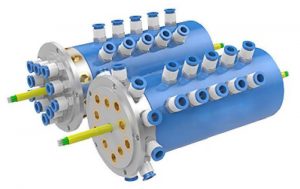
◆ Support M5, G1 / 8, G1 / 4, G3 / 8, G1 / 2, G3 / 4, G1 thread for pneumatic
◆ Dynamic sealing technology
◆ With NSK high precision bearing
◆ Abrasion resistant, low torque, high speed
◆ Can be combined to transfer 2~96 circuits power and signal
| Electrical Data | Mechanical Data | ||
|---|---|---|---|
| Rated Voltage | Power: 0~440 VAC/VDC Signal: 0~240 VAC/VDC | Max. Speed | 400RPM |
| Insulation Resistance | Power: ≥1000MΩ/500VDC Signal: ≥1000MΩ/500VDC | Max. Pressure | 10Bar |
| Insulation Strength | 500VAC@50Hz, 60s | Working Temperature | -30℃~+80℃ |
| Lead Wires | Standard (adjustable) | Working Humidity | 0~85% RH |
| Lead Length | Standard 300mm (adjustable) | Housing Material | Aluminum Alloy |
| Electrical Noise | <0.01Ω | Protection Grade | IP51 |
Pancake Slip Ring
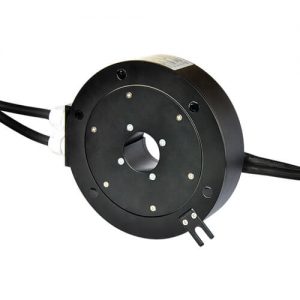
The pancake slip ring is similar to through through-hole slip ring but is especially used for the rotating system with a height limit. Also called flat slip ring, flat disc electrical slip ring, or platter slip ring, since the shape is similar to a platter, rings, and brushes contact around the center of the circle. Pancake slip ring components include stator, rotor, and contacts, mainly used for transmitting precise signals and power or combined with pneumatic and hydraulic media. More electrical power, current, and signal circuits can extend broadwise limitless on flat diameter.
Pancake slip rings can be configured in two types, integrated and separated.
Integrated ring types can be designed for solid or through-hole rotating systems.
The separated ring type is composed of a separated rotor and contact brush, which can be designed with PCB.
Waterproof Slip Ring
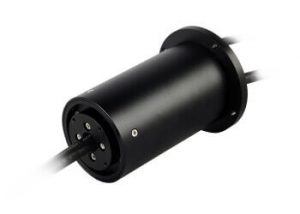
A waterproof slip ring is especially for working under moisture, corrosion, and underwater. The protection grade will be IP65, IP67, and IP68, and the liquid components in the working environment such as freshwater, seawater, oil should be considered. Waterproof slip rings are widely used in ships, harbor equipment, and some water or moisture environment working conditions. The units work well for transmitting precision signals, and electrical power.
In summary, understanding the classifications, features, and differences of various IP-rated enclosed slip rings, and identifying their best-suited scenarios is crucial in determining the appropriate slip ring for your specific application and ensuring optimal performance in varying environmental conditions.
Working Principles of IP-Rated Enclosed Slip Rings
To gain a comprehensive understanding and make informed decisions about IP-rated enclosed slip rings, it’s essential to delve into their technical principles, operating characteristics, and key components that dictate their function.
Technical Principles
IP-rated enclosed slip rings employ the electromagnetic induction principle to facilitate smooth power and signal transmission between the stationary and rotating parts of a system. At the core, these slip rings consist of a conductive ring and a brush that come into conductive contact while ensuring minimal friction and wear. Consequently, they create a continuous electrical connection, enabling uninterrupted transmission of power, data, or signals across the rotating interface.
Operating Characteristics
The primary characteristic of IP-rated enclosed slip rings is the rotational interface that allows them to maintain continuous electrical connections. These devices typically exhibit a balanced design and structure to endure the high demands of challenging environments, such as the combination of constant rotation, temperature fluctuations, and exposure to dust and water. IP-rated enclosed slip rings showcase low electrical noise during operation, which is vital for the stable transmission of sensitive signals. Moreover, they are designed to offer longevity and provide reliable performance over extended periods.
Components and Their Functions
IP-rated enclosed slip rings typically consist of several essential components, each serving specific functions:
- Rotor: The rotor constitutes the rotating part of the slip ring assembly, providing the required conductive paths for the transmission of power or signals.
- Stator: The stator is the stationary part of the assembly that houses the brush contacts and maintains an electrical connection with the rotor.
- Brushes Brushes are conductive elements (usually made of precious metal alloys or graphite), responsible for bridging the electrical connection between the rotating rotor and the stationary stator. They ensure smooth and controlled electrical contact with minimal friction, enabling efficient transmission throughout the rotation.
- Bearings: Bearings are vital for supporting the rotating assemblies, promoting smooth and effective rotation while reducing friction and wear.
- Enclosure: The enclosure is the protective housing, shielding the internal components of the slip ring from environmental elements. It plays a significant role in ensuring the slip ring’s IP rating and overall durability.
In conclusion, understanding the working principles, operating characteristics, and vital components of IP-rated enclosed slip rings can help users better appreciate their unique features, make well-informed decisions, and integrate these devices into their applications more effectively.
Features of IP-Rated Enclosed Slip Rings
A clear understanding of the unique and advanced features of IP-rated enclosed slip rings, in comparison with traditional slip rings, and their benefits and limitations can help users evaluate their suitability for specific applications and deploy them more effectively.
Unique and Advanced Features
IP-rated enclosed slip rings come with a range of distinct and advanced features:
- Ingress Protection: As suggested by their names, IP-rated enclosed slip rings boast enclosures designed to provide varying degrees of protection against solid objects, dust, and liquids, ensuring their optimal performance in diverse and challenging environments.
- Minimal Friction and Wear: These slip rings often incorporate high-quality, conductive materials (such as precious metal alloys or advanced conductive plastic) for brushes and contact surfaces, reducing friction and wear during operation, leading to enhanced durability and reliability.
- High Signal Integrity: The thoughtful design of the brushes and rotor contacts enables low electrical noise and minimal signal fluctuations, ensuring high signal integrity even in challenging conditions.
- Wide Application Range: IP-rated enclosed slip rings can cater to a vast range of applications, including high-speed data transmission, high-frequency signals, and combinations of power, signals, and data. They can also support different types of transmission media, such as optical fibers, hydraulic fluids, or pneumatic tubes
Comparison with Traditional Slip Rings
Compared to traditional slip rings, IP-rated enclosed slip rings offer several notable advantages:
- Enhanced Protection: IP-rated enclosed slip rings provide increased protection against environmental factors, such as dust, moisture, and solid objects, ensuring extended operational life and reduced maintenance requirements.
- Reliable Performance: The careful design and material choices lead to lower friction, wear, and electrical noise, delivering a more reliable and consistent performance in various applications.
- Versatility: IP-rated enclosed slip rings can accommodate a broader range of applications, including demanding environments, high-frequency signals, or complex transmission media, offering versatility and flexibility for diverse projects.
Benefits and Limitations
While IP-rated enclosed slip rings offer numerous benefits, they also come with certain limitations:
Benefits:
- Enhanced durability and reliability, primarily due to their ingress protection against dust, water, and solid particles.
- A wider range of applications, catering to both conventional and challenging environments.
- High signal integrity and minimal electrical noise, lead to more stable and accurate transmission.
Limitations:
- Higher initial costs compared to traditional slip rings, as they comprise specialized designs and materials to achieve the IP rating.
- Potential for increased maintenance requirements, mainly if used in scenarios with erratic misalignments or extreme conditions that exceed the specified IP rating.
In summary, understanding the features of IP-rated enclosed slip rings, their comparison to conventional slip rings, and their benefits and limitations allows users to make well-informed decisions, ensuring that these slip rings can be deployed appropriately and effectively in their respective applications.
Applications of IP-Rated Enclosed Slip Rings
IP-rated enclosed slip rings are designed to be versatile and robust, which makes them suitable for several fields of use. Case studies and examples will demonstrate these applications more explicitly.
Fields of Use
Wind Energy

IP-rated enclosed slip rings have a critical role in wind turbines, allowing for continuous electricity transfer from the rotating blades to the stationary grid.
Military and Defense

Due to their robustness and reliability, these slip rings are widely used in military vehicles, naval ships, radar systems, and defense communication systems.
Industrial Machinery
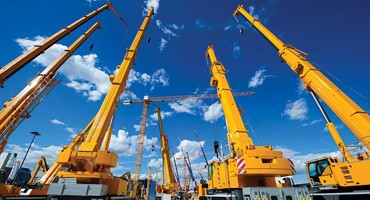
They find extensive use in rotary tables, robotics, packaging machines, and other rotating equipment where they maintain power and signal connections in these dynamic environments.
Medical Technology

IP-rated enclosed slip rings find applications in medical imaging devices like CT scanners that require smooth and continuous rotation for proper functioning.
Marine Industry
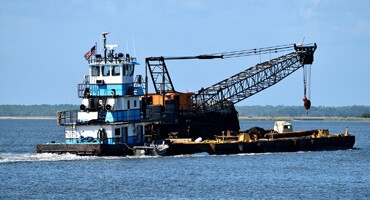
Thanks to their high level of protection against moisture and dust, these slip rings can be found in submersibles, ROVs (Remote Operated Vehicles), and other marine equipment.
Amusement Rides

They are essential in amusement rides like Ferris wheels and roller coasters, ensuring continuous power transmission to moving parts.
Case Studies or Examples of Applications
- Case Study – Wind Turbines: A leading wind turbine manufacturer needed a reliable solution to transfer power from the rotating turbine blades to the stationary grid. They deployed IP65-rated enclosed slip rings, offering complete dust protection and resistance to low-pressure water jets. This application helped the manufacturer ensure continuous power production without interruptions due to environmental factors.
- Example – CT Scanners: In medical imaging devices like CT scanners, the scanner’s gantry rotates around the patient, requiring a constant power supply. For this purpose, an IP54-rated enclosed slip ring, resistant to dust and capable of withstanding water splashes, is used to provide steady power and signal transmission. This promotes a seamless scan operation for accurate and timely diagnostic data.
- Application – Submersibles: In a project to study deep-sea marine life, a scientific organization used an ROV equipped with cameras and sensors. Since the equipment needed to operate under high-pressure water conditions, an IP68-rated enclosed slip ring was used. The slip ring enabled continuous power supply and signal transmission under these challenging conditions, successfully aiding the study.
In conclusion, the myriad of applications, ranging from wind turbines to amusement rides, signifies the critical role played by IP-rated enclosed slip rings. Their unique features and enhanced protection levels make them the preferred choice for a plethora of fields, offering optimal and reliable performance even under demanding environmental conditions.
Considerations when Selecting IP-Rated Enclosed Slip Rings
Selecting the right IP-rated enclosed slip ring requires considering multiple parameters such as size, rotation speed, IP rating, and connection types. Furthermore, there are several tips for effectively matching slip rings to application requirements.
Factors to Consider
- Size: Size is a critical consideration when selecting a slip ring. The device must physically fit into the space provided in the equipment. Both inner bore size and overall diameter must be considered.
- Rotation Speed Different slip rings can withstand a variation in rotation speeds. Understanding the exact or approximate rotational speed of your application is vital to avoid excessive wear or heat generation in the slip ring.
- IP Rating: The choice of IP rating largely depends on the operating environment. If the machine operates in an environment prone to dust or moisture, a higher IP rating will be necessary to ensure reliable performance.
- Power/Signal Requirements: Depending on the application, the slip ring may have to carry different types of data signals, control signals, or power. Clear comprehension of these requirements is essential to select the correct type and size of the conductive paths.
- Connection Type: The choice of connection type depends on the requirements for installation ease and convenience, maintenance, and reliability. Consider whether a flange mount, through-hole, or standalone design best suits your application.
- Material Compatibility: The choice of material influences durability, conductivity, and compatibility with the working environment. Consider components like brushes and rings, which need to be made from materials that minimize friction and wear while ensuring high conductivity and corrosion resistance.
Tips on Matching Slip Rings to Application Requirements
- Application Analysis: Understand the specific requirements and constraints of your application. These will include rotation speed, installation space, the need for transmission of data or power, environmental conditions, and potential variables within these factors.
- Engage Experts: Engage with slip ring manufacturer’s engineers or experts in this field to analyze your application requirements, provide feasible solutions, and recommend a suitable product.
- Detailed Specifications: Once you understand your application’s requirements, focus on the specifications of the available slip ring models. Cross-check each specification (like size, speed, power, and data transmission capabilities) with your application needs.
- Trial and Testing: Always consider testing the slip ring in a controlled environment similar to the actual application conditions before finalizing your purchase. Regular wear and tear, temperature variations, and resistance to external factors such as dust and moisture should be tested.
In summary, selecting the right IP-rated enclosed slip ring involves paying close attention to a variety of aspects from both the application and the slip ring itself. A methodical approach to choosing the right slip ring can significantly improve performance and service life, leading to more reliable and efficient operations.
Installation and Maintenance of IP-Rated Enclosed Slip Rings
Proper installation, regular maintenance, and timely troubleshooting of IP-rated enclosed slip rings are essential for their smooth and efficient operation. It’s also crucial to detect and respond to warning signs in time to prevent device failure.
Installation Guide
Installation of IP-rated enclosed slip rings typically includes the following steps:
- Environment Inspection: Before installation, check the environment. Ensure it is free of extreme dust, moisture, heat, or any other condition that could potentially damage the slip ring.
- Physical Placement: Depending on the design, attach the slip ring to the respective equipment part. Ensure that it aligns well with the rotary interface.
- Electrical Connections: Connect power and signal wires as per the instruction manual. Ensure a proper and firm connection to avoid loose connections that may cause intermittent signal transmission.
- Safety Checks: After installation, conduct necessary safety checks. Confirm that the slip ring rotates freely and that the electrical connections are secure and insulated.
Maintenance and Troubleshooting Tips
Regular maintenance and efficient troubleshooting can extend the lifespan and maintain the performance of the slip rings:
- Regular Cleaning: Keep the slip ring clean from dust, moisture, or any other foreign bodies that might affect its performance.
- Component Inspection: Inspect components regularly for any signs of wear and tear or heat damage. Check for any exposed or frayed wires.
- Lubrication: Some slip rings might require occasional lubrication to decrease wear and tear and ensure smooth operation.
- Troubleshooting: If you experience any operational issues, refer to the manufacturer’s troubleshooting guide. If the problem persists, contact the manufacturer’s technical support.
Warning Signs to Watch Out for
Paying attention to early warning signs can prevent severe damage and help maintain device performance:
- Unexpected Noise: Any unusual noise like grinding or squeaking during operation might indicate a problem with the slip ring.
- Fluctuating Signals: Inconsistent signals or power supply may indicate worn-out contacts or faulty connections.
- Overheating: If the slip ring becomes excessively hot, it might be a sign of overloading, inadequate cooling, or friction due to misalignment.
In conclusion, correct installation, proactive maintenance, and paying close attention to any warning signs are key to ensuring a long, efficient, and failure-free service life of IP-rated enclosed slip rings. If you are not confident about any of the aspects of the process, professional help is advisable.
Future Development and Trends of IP-Rated Enclosed Slip Rings
IP-rated enclosed slip rings occupy a pivotal role in various industries that require rotational power or signal transmission. Their applicability and relevance continue to grow with rapid technological advancements and changing market trends. Here’s a closer look at the future developments and trends.
Technological Advancements
Technological advancements are diversified, constantly shaping the landscape of enclosed slip rings.
- Miniaturization: There’s a growing digital trend demanding smaller and more efficient devices. The miniaturization trend is driving the development of compact, high-performance slip rings that can operate in limited spaces without compromising performance.
- Intelligent Functions: The advent of the Internet of Things (IoT) and AI is making way for more intelligent slip rings capable of monitoring their performance, predicting maintenance needs, and communicating with other devices in the system for improved efficiency and safety.
- High-Speed Data Transmission: While conventional slip rings provide limited bandwidth, there’s a growing need for gigabit transmission capabilities due to the expansion of 5G communications and ballooning data requirements. Future slip rings are expected to offer more robust, high-speed communication capabilities.
Future Market Trends and Forecast
Several market trends are influencing the future of the IP-rated enclosed slip rings:
- Increasing Demand in Renewable Energy: The global emphasis on green energy, especially wind energy, is a significant driver for the growth of the slip rings market. High-performance slip rings play a critical role in wind turbines, transferring power and data from the rotating wind turbine blades to the stationary grid.
- Rise in Automation and Robotics: There is a steady upswing in automation and the use of robotics in various industries, including manufacturing, healthcare, and defense. Enclosed slip rings are vital for these applications, contributing to a forecasted growth in demand.
- High Precision Applications: The demand for highly precise, reliable, and durable slip rings will likely increase as they find key applications in sensitive and critical industries such as medical, defense, and aerospace.
The future for IP-rated enclosed slip rings looks promising, driven by technological advances and changing market needs. Continuous innovation and development are expected to further amplify their role across diverse industry sectors.
Conclusion
In the realm of rotating equipment and machinery, IP-rated enclosed slip rings play an essential role in contributing to operational efficiency, connectivity, and safety. This guide has provided an in-depth look at these pivotal components from different perspectives, highlighting their importance, different factors to consider during selection, installation, maintenance procedures, and common questions.
In recap, important points to remember include:
- Understanding Your Application Needs: Analyzing the specific requirements of your application is fundamental in choosing the appropriate slip ring. Factors to consider include the size, rotation speed, IP rating, power and signal requirements, connection types, and material compatibility.
- Importance of Installation and Maintenance: Proper installation, regular maintenance, and swift troubleshooting are integral for the optimal functioning of slip rings. Remember to look out for and properly address warning signs to prevent operational failures.
- Staying Informed: With the constant influx of advanced technologies and market trends, staying informed about the latest developments is crucial. Understanding market trends, industry insights, and best practices can help you make informed decisions.
Final tips and advice pertaining to IP-rated enclosed slip rings:
- Product Quality: Always prioritize the quality of the slip ring. Despite initial cost considerations, a poor-quality slip ring can lead to recurring issues and additional costs in the long run.
- From a Trusted Supplier: Ensure the manufacturer or supplier you choose has robust customer service and technical support to assist with any installation, maintenance, or troubleshooting issues.
- Adherence to Specifications: Strictly adhere to the product’s specified limits and guidelines to maximize its lifespan and maintain its performance.
- Regular Maintenance: While enclosed slip rings are relatively low in maintenance, regular check-ups and preventive maintenance can immensely increase their lifespan and operational efficiency.
In conclusion, IP-rated enclosed slip rings are an important subset of a bigger family of mechanical and electrical components that fuel our everyday lives. By understanding them better, we not only improve our knowledge but also our ability to make smarter decisions that lead to efficient and reliable operations.
FAQs about IP-Rated Enclosed Slip Rings
Enclosed slip rings, with their different IP ratings, are a topic that interests many professionals involved in various fields. Their applications, best practices, and industry insights often raise several questions. Here are some common FAQs to clarify doubts regarding IP-rated enclosed slip rings.
Common Questions and Doubts
Q: What does the IP rating signify in an IP-rated enclosed slip ring?
A: The IP rating in an IP-rated enclosed slip ring refers to its Ingress Protection rating. It indicates the level of protection offered by the slip ring enclosure against solid objects (including dust) and liquids.
Q: Can IP-rated enclosed slip rings operate in extreme temperature conditions?
A: Yes, but it largely depends on the material and design of the slip ring. Before deploying in extreme temperature conditions, it’s advisable to consult with the manufacturer or refer to the product’s technical specifications.
Q: Can an IP-rated enclosed slip ring transmit power and data simultaneously?
A: Yes, many slip rings are designed to transmit power and various forms of data simultaneously.
Best Practices
Q: Which IP-rated enclosed slip ring should I choose for my application?
A: You should choose the slip ring based on your application’s requirements and the environment in which it will be operating. A full understanding of the application, including the necessary speed, size, power, and signal requirements, as well as environmental factors, will help determine the suitable slip ring.
Q: How can I extend the lifespan of my enclosed slip ring?
A: Regular maintenance, including cleaning and inspection, appropriate lubrication if required, and accurate utilization according to the product specifications, will help extend the lifespan of your slip ring.
Industry Insights
Q: What are the emerging trends in the slip ring industry?
A: The slip ring industry has witnessed several trends, including compact designs for limited spaces, hybrid models that transmit power and signals simultaneously, and the adoption of materials to enhance durability and performance.
Q: How is the growing wind energy sector impacting the slip ring industry?
A: The wind energy sector heavily employs enclosed slip rings for power transmission from the wind turbines’ rotating blades to the stationary grid. Consequently, the rise in the wind energy sector has led to an increase in demand for dependable and efficient slip rings, pushing the industry to evolve and improve.
These FAQs should provide a solid basis of understanding regarding IP-rated enclosed slip rings. However, it’s essential to remember that every application is unique, and there might be more specific questions depending on individual circumstances.


